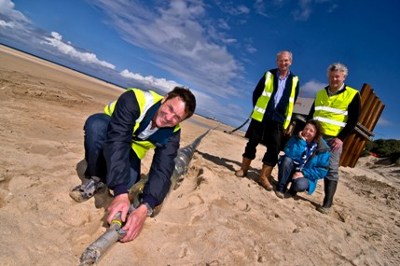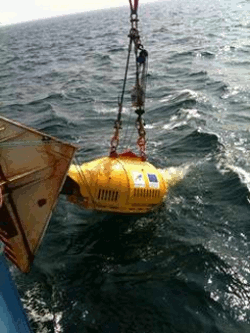Wave Hub the World's Largest Wave Energy Test Site gets Plugged in to the Power Grid
This past week, on Tuesday 2nd November 2010, the world's largest wave energy test site was plugged in to the United Kingdom's National power grid and has undergone its first full tests. Declared as officially open for business, the project known as Wave Hub, located off the shores of Cornwall in South West England is the culmination of over 7 years' work to produce a world-leading site where various different wave power technologies can be trialled to see how well they work and how much power they can generate.
The wave hub doesn't generate power itself. Instead, it's a kind of socket, located around 10 miles (16 kilometers) off the coast of Cornwall, at a depth of around 50 metres below the sea's surface. The hub is permanently connected to the UK's National electricity Grid by way of an undersea cable.
Into this socket (the Wave Hub), actual wave power generating devices which float on the sea's surface or slightly below the surface can be connected. These wave power generators can then be fully tested before they go into full scale production and deployment. The hub is effectively therefore a plug-and-play mechanism and infrastructure for testing new wave power technology, allowing companies or inventors to put their devices through full real-world testing without the need to go to the huge expense of laying the connecting infrastructure themselves. Four separate cable tails, each 300 metres long, stretch out from the Wave hub. These 4 tails will be used as the connectors to serve the 4 separate ocean "berths" that are available for wave power generating projects. Each berth spans two square kilometers of the ocean. You can get a good idea of how everything fits together in this Wave Hub schematic pdf or in the video further down this page.
It is anticipated that the first wave power generators will be connected to the Wave hub in 2011. A company called Ocean Power Technologies, based in Warwick, England, are the first to sign an agreement for one of the births. They plan to use their birth for their PowerBuoy wave power generation devices which use "smart" technology to capture the power of the sea. The PowerBuoy units transmit real-time information to the shore and in the event of extremely high oncoming waves, the system locks up and stops producing power. Only when the waves return to normal size does the system unlock itself and recommence power production. Ocean Power Technologies intends to install a 150 kilowatt version of PowerBuoy at Wavehub, and are also developing a larger 500kW version, known as PB500 which they believe will be able to effectively compete with fossil fuels in larger production volumes.
In total, the Wave Hub has an initial maximum generation capacity of 20 Megawatts, which is enough energy to power around 7,000 average homes. Its design allows it to have the potential to increase this capacity to 50 Megawatts in the future.
The £42 million wave Hub project has been funded by £12.5 million from the South West Regional Development Agency, £9.5 million from the UK government and £20 million from the European Regional Development Fund Convergence Programme.
Getting the wavehub in place and connected to the National Grid has been a tricky operation which has not been without delays.
The armoured 16 mile (25 km) cable which connects the Wave Hub to the shore was made in a single continuous length. It is composed of six 33kv capacity copper power cores and 48 fiber-optic cables. This is then sheathed with polyethylene and 2 layers of high tensile steel wire armouring and an outer polymer sheath. Overall its diameter measures 16 centimetres (6.3 inches).

The end of Wave Hub's undersea cable at Hayle Beach with South West RDA General Manager Guy Lavender
The first of the intricate big jobs was bringing the end of this hefty subsea cable ashore at Hayle in Cornwall on 23 August 2010. Over 400 buoys were employed to float a 1,800 metre length of cable which weighed around 90 tonnes. The end was then pulled to the top of the beach where would be joined to onshore cables linked to a new electicity substation at Hayle. The first two attempts at getting the end on land were unsucessful when the cable lost buoyancy on both occasions. The third, and finally succesful attempt used a different method than the first two, employing a combination of A5 buoys and pillow floats. Seeing the cable finally brough ashore, Guy Lavender of the South West RDA expressed great relief after the first two tries.
This was just the beginning though - the next step was to bury the cable about 2 metres deep on the beach, whilst the ship Nordica travelled out to the final point where the Wave Hub would rest, laying the 1,300 tonne 25km long cable as the ship sailed. A special machine using high pressure water jets was used to blast the trench at the beach. This machine was able to keep going out to 2 kilometers offshore, after which a larger trenching machine would take its place for an additional 5 kilometers distance. Beyond the 7 kilometer point the seabed was too hard to trench, so the cable is kept in place using 91,000 tonnes of rocks, laid on top of it by a ship known as Tideway Rollingstone .
Video of the start of drilling at Hayle Beach to lay Wave Hub's 25km cable

Wave Hub being lowered from Nordica into the sea
At the distance of 16 kilometers offshore as the crow flies, the 12 tonne Wave Hub itself was delicately lowered from the Nordica using the ship's onboard crane. Passing down through 55 metres of water, the hub settled in place on the sea bed on Friday 3 September 2010. Over the next 2 days the Wavehub's 4 tails, each 300 metres long, were laid out in position on the ocean floor, and then the Tideway Rollingstone began laying those 91,000 tonnes of rock to keep the cable between the Wave Hub and the shore in place.
Throughout its installation the Wave Hub and cable underwent tests to check the system's integrity. Finally on Tuesday 2 November 2010 a full test of the entire system was carried out, when the 33,000 volt cable was connected to the UK national electricity grid through the substation at Hayle. The Wave Hub team were delighted that this went without a hitch. From now onward the system will be peramently connected and monitored.
To further ensure that the 25km cable is kept securely in place, 177 concrete "mattresses" have been laid at regular intervals on top of the 91,000 tones of rock which cover the cable. The last of these mattresses was put into place the day after the final tests, on 3 November.
The very last task of the physical installation is effectively to place what you may call a cherry on top of everything - a marker buoy to indicate the location of the Wave Hub will be put in place next week.
It is anticipated that the Wave Hub will remain in place for 25 years, allowing a wide range of tests to be carried out on various new wave power generation devices.

- Renewable Energy:
- Login to post comments
